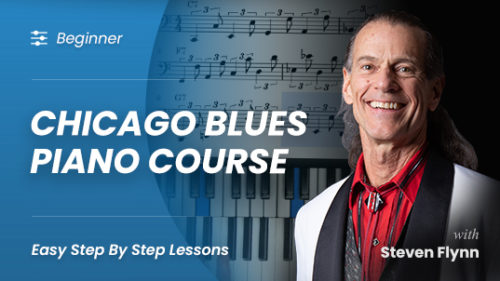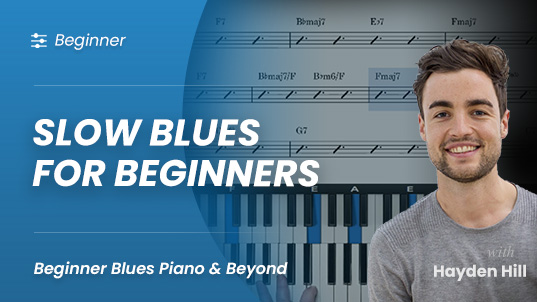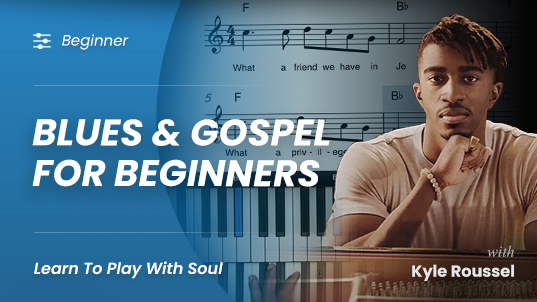Chicago Blues Piano Course
In this step-by-step course we cover the blues form, bass lines, shuffle patterns, chord voicings, turnarounds & improv. Learn to play authentic Chicago Blues piano.
to this course, right now!
Summary Information:
One-time purchase - learn at your own pace, with unlimited access to this course.
- Difficulty: Beginner
- View Online with Lifetime Access
- Video Slow Down Controls
- A/B Loop
- Theory Lessons
- Performances & Arrangements
- 11 PDF Files & Lesson Supplements
Chicago Blues Piano Course
In this step-by-step course we cover the blues form, bass lines, shuffle patterns, chord voicings, turnarounds & improv. Learn to play authentic Chicago Blues piano.
In this course we focus around a post-war Chicago Blues style that applies to the 12 bar blues many other styles of improvised music.
The Origin Of The Blues
The form we recognise as blues today developed in the late 19th and early 20th century in the American south.
It has roots in the music brought from Africa by slaves. Field hollers and work songs sung by workers in the agricultural south, provided a rhythm for doing monotonous, arduous work in the fields, as well as adding an emotional outlet for that life.
They were part of the music of the late 1800’s that eventually evolved into blues, spirituals, jazz, rhythm and blues, and most forms of African- American music.
The Harmonic Structure Of The Blues
The 12 bar form is the most basic and common type of blues form. However, there are other variations such as 8 bars blues, 16 bar blues, and 32 bar blues.
The most basic variation of the 12 bar blues is comprised of just 3 chords:
- The I7 Chord
- The IV7 Chord
- The V7 Chord
We will start by constructing the blues with just these 3 chords and then we will explore the variations and substitutions that we can apply to this basic structure.
Blues Shuffle Patterns
We start by playing the blues shuffle pattern based around a 5th and 6th interval in our left hand. This is one of the most useful patterns to learn because of its simplicity.
It creates both a solid groove, and also harmonic interest at the same time. The 5th interval is unique because it can be played in the lower registers of the piano without it sounding “muddy”.
When working on our hand independence, we must train our left hand to play this rhythm almost subconsciously which frees up our right hand for melodic creativity.
Blues Comping Patterns
Triads, 7th Chords, 9th Chords, & 6th/13th Chords are all used in the blues for comping.
Whilst we can comp with basic triad shapes, the dominant 7th is a very useful sound to incorporate into our chords and voicings when comping.
We can also extend our voicings to include 9ths and 13ths. Steve demonstrates some clean voice leading principles using these colourful extended chord voicings.
Blues Licks & Riffs
The blues licks and riffs lesson will inspire you to build your own vocabulary that you can use to improvise when playing the 12 bar blues.
In this lesson we cover:
- Easy blues licks
- Hammered 8th notes
- Rolls, slurs, & slides
- Dr John’s ‘Famous Lick’
- Licks built from 3rd & 6th
In this course we’re going to focus around a post-war Chicago Blues style that applies to many other styles of blues and improvised music.
In this lesson we explore the harmonic and rhythmic structure of the blues, how the blues is constructed, and how it is commonly played.
In this lesson we will shift the focus onto our left hand and explore some useful left hand patterns, mainly focusing on the shuffle feel.
In this lesson we will explore some useful voicings, patterns, and rhythmic ideas for right hand comping over the 12 bar blues.
This lesson on licks and riffs will inspire you to build your own vocabulary that you can use to improvise when playing the 12 bar blues.
In this lesson we will be exploring the common intros, endings, and turnarounds that are found in the Chicago blues piano style.
"Spann's Stomp" follows the 12 bar form which we explored in the earlier lessons. We are going to play the tune in the key of C.
You will immediately notice that this tune does not follow the standard 12 bar blues form that we have covered earlier in this course.
-
12 Bar Blues Variations File Type: pdf
-
Left Hand Shuffle Patterns PDF File Type: pdf
-
Single Note Bassline Patterns File Type: pdf
-
Comping Patterns Lesson Notation File Type: pdf
-
Licks & Riffs Lesson Notation File Type: pdf
-
Intros, Endings, & Turnarounds Lesson Notation File Type: pdf
-
“Spann’s Stomp” Improvisation File Type: pdf
-
“Trouble In Mind” Chord Changes File Type: pdf
-
“Trouble In Mind” Transcription File Type: pdf
to this course, right now!





